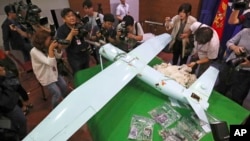North Korea sent several small drones into South Korean airspace Monday, Seoul officials said, prompting South Korea’s military to fly its own unmanned surveillance aircraft north of the sensitive border.
South Korea also scrambled fighter jets and attack helicopters to respond to the North Korean incursion but failed to bring down any of the drones, according to South Korean military officials.
While one of the drones returned to North Korea, the status of four others is not known, said South Korean military officials who spoke to reporters on background late Monday.
It’s not clear if the North Korean drones were armed, though South Korean officials say they were small – with a wingspan of only about 2 meters.
North Korea has sent tiny, crudely built UAVs into South Korea for apparent surveillance missions at least four other times since 2014, though this is the first reported incursion in more than five years.
Monday’s incident appeared particularly brazen, as the North Korean drones were reported to have flown around populated areas of South Korea for much of the day.
The first North Korean UAV crossed the border near South Korea’s northeast island of Ganghwa at 10:25 am local time and was quickly followed by the others, according to South Korean military officials.
Four of the drones flew near Ganghwa, while the other flew as far as the northern part of the Seoul metropolitan area, which is approximately 50 kilometers away, officials added.
As of 8:00 pm local time, there was no indication that any of the drones had been captured. There were no reports of damage in South Korea.
According to South Korea’s transport ministry, aircraft departures were temporarily halted at South Korea’s main Incheon Airport and the smaller Gimpo Airport, both of which are close to the reported North Korean intrusions.
The incident is likely to raise questions about South Korea’s ability to prevent North Korean drone incursions and whether the South Korean military acted quickly enough to stop the unmanned vehicles.
According to a South Korean military background briefing, South Korea fired about 100 shots but failed to bring down any of the North Korean drones.
One of the South Korean aircraft involved in the response – a KA-1 light attack aircraft – crashed east of Seoul, though officials have not explained why. Neither pilot in the plane was injured, officials said.
In response, South Korea’s military said it sent a drone into North Korea on a reconnaissance mission. The South Korean drone reached about as far into the North as the North Korean drones intruded into the South, before returning south of the border, officials added.
In a statement, South Korea’s Joint Chiefs of Staff condemned North Korea’s “clear act of provocation” and vowed the South would continue to respond “thoroughly and firmly” to North Korea.
This is the first known North Korean drone incursion into South Korea since 2017, when a suspected North Korean drone mounted with a camera took photos of a U.S. anti-missile battery before crashing on its way back to the North.
In 2014, a similar North Korean unmanned aerial vehicle took pictures of military installations and even the residence of South Korea’s president before crashing near the border.
South Korean officials say the drones identified Monday appeared to be similar to those used in the 2014 and 2017 incidents.
North Korea has not commented on the incursion, but in the past has denied sending spy drones into South Korea.
North Korea has steadily ramped up tensions this year, launching a record number of missiles and conducting artillery shelling in sensitive border areas.
South Korean President Yoon Suk Yeol, a conservative who took office in May, has responded with corresponding shows of military might, often within a few hours of the North Korean provocations.








